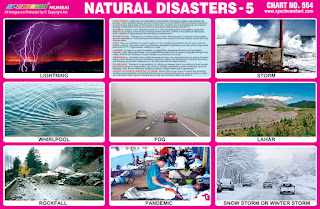 |
| Natural Disasters - 5 Chart |
Spectrum Chart - 554 : Natural Disasters - 5
1. Lightning - Lightning is a powerful
electrical discharge made during a thunderstorm. The electric current
is very hot and causes the air around it to expand very quickly,
which in turn makes thunder. Sometimes it happens between clouds.
Sometimes (in the rain) it goes from cloud to ground. If it goes from
cloud to ground, it can strike a person. Around 2000 people are
struck by lightning each year.
2. Storm - Storm means violent weather,
usually heavy rain and wind. Hurricanes, typhoons, and tornadoes are,
often, called storms too but they have special names because they are
very, very strong. Storms generally lead to negative impacts on lives
and property such as storm surge, heavy rain or snow, lightning,
wildfires and vertical wind shear.
3. Whirlpool – A whirlpool is a body of
swirling water produced by the meeting of opposing currents. The vast
majority of whirlpools are not very powerful and very small
whirlpools can easily be seen when a bath or a sink is draining. More
powerful ones in seas or oceans may be termed maelstroms. Vortex is
the proper term for any whirlpool that has a downdraft. In oceans, in
narrow straits, with fast flowing water, whirlpools are normally
caused by tides. Powerful whirlpools have killed unlucky seafarers.
4. Fog - Fog is mist when it is very
thick. It may appear on land or sea. It usually lowers visibility.
Fog is made up of tiny water droplets or in very cold conditions, ice
crystals. When seen on a high speed camera, it looks like hundreds of
small water droplets moving through the air. These water droplets
make up the fog. The thickness of fog varies depending on the
atmosphere, temperature, weather and location.
5. Lahar - A lahar is a volcanic mudflow
or debris flow composed of a slurry of pyroclastic material, rocky
debris and water. The material flows down from a volcano, typically
along a river valley. Lahars are extremely destructive: they can flow
tens of metres per second, be 140 metres deep and destroy any
structures in their path. Notable lahars include those at Mount
Pinatubo and Nevado del Ruiz, the latter of which killed thousands of
people.
6. Rockfall – A rockfall refers to
quantities of rock falling freely from a cliff face. The term is also
used for collapse of rock from roof or walls of mine or quarry
workings. A rockfall is a fragment of rock detached by sliding,
toppling or falling, that falls along a vertical or sub-vertical
cliff, proceeds down slope by bouncing and flying along ballistic
trajectories or by rolling on talus or debris slopes.
7. Pandemic – A pandemic is an epidemic
of infectious disease that has spread through human populations
across a large region, for instance multiple continents or even
worldwide. Throughout history, there have been a number of pandemics,
such as smallpox and tuberculosis. One of the most devastating
pandemics was the Black Death, killing over 75 million people in
1350. The most recent pandemics include the HIV pandemic and H1N1
pandemics.
8. Snow Storm or Winter Storm - Snowstorms
are storms where large amounts of snow fall. Snowfalls in excess of 6
inches (15 cm) are usually universally disruptive. A massive snowstorm
with strong winds and other conditions meeting certain criteria is
known as a blizzard. Snowstorms are usually considered less dangerous
than ice storms. However, the snow can bring secondary dangers.
Snowstorms can produce cornices and avalanches.

No comments:
Post a Comment